
Textile production requires large amounts of water
Water consumption in all process steps
Water is required in almost all process steps of textile production:
- the cultivation of agricultural crops such as cotton
- the rearing of animals whose wool or feathers is used such as sheep and geese
- the production of synthetic fibers such as polyester
- in all washing, dyeing and finishing processes
The WWF assumes that the textile industry consumes 13.6 liters of water for every euro of turnover. 43% of this is accounted for by wet processes such as washing, dyeing and finishing of textiles.
In a pilot project VAUDE has conducted an Environmental Stewardship training course with a number of its suppliers. As a result, more than 5,000 cubic meters of fresh water are saved in production every year. Read more here.
Most of our fabric suppliers work in accordance with the bluesign® system. For VAUDE, this is an important component of the entire environmental stewardship system.
Nevertheless, we often do not know the hard figures for our suppliers’ water consumption. One reason for this is that we are often only one of many of their customers. Another reason is that a uniform method for measuring the water consumption of an outdoor product is still lacking.
This gap will hopefully be closed by the HIGG Index – an international database to evaluate the sustainability of your outdoor trousers, jackets, etc. in the future. Read more here.
Great potential for savings
In addition to a focus on the careful use of water in production, we are also working with our suppliers to process more and more substances that have been produced using particularly water-saving technologies. This includes more eco-friendly dyeing technologies: For example, modern dyeing machines save up to 30 % water and 70 % chemicals compared to older designs. More about this here.
The issue of water will become increasingly important in the coming years as global water resources become scarcer. In the textile industry new, resource-saving solutions must be found.
| GRI: | 303-1 |
| GRI: | 303-2 |
| GRI: | 303-3 |
| GRI: | 103 |




